
|
December 2010
|
|
|
The U.S. Department of Energy's Thomas Jefferson National Accelerator Facility
|
|
Researching Niobium Gilding in Bid for Better Beams |
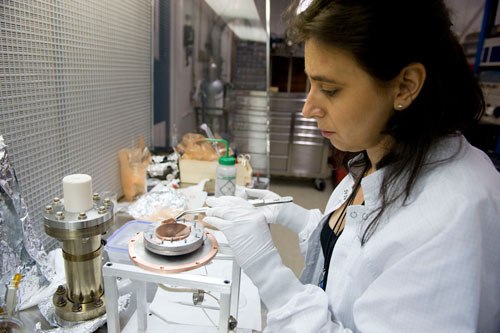 Anne-Marie Valente, SRF Institute research scientist, and her colleagues are using a technique called energetic condensation by electron cyclotron resonance to produce and apply thin films of niobium to copper, aluminum and other test metals in the ECR Plasma Deposition Lab.
For thousands of years, craftsmen have applied gilding, a thin layer of gold, to objects to enhance their value. Now, Jefferson Lab researchers are using this same idea to enhance materials for accelerator science. As the number of uses for accelerators grows, scientists are faced with the challenge of building low-cost accelerators that offer high performance. And to meet that challenge, scientists at Jefferson Lab are combining a bit of the old with the new. Jefferson Lab SRF Institute Research Scientist Anne-Marie Valente and her colleagues are exploring the application of a thin film of niobium to other materials, such as copper, to make better accelerator components. "We want to replace, in certain projects, the bulk niobium with niobium on copper. The niobium on copper has potential advantages over bulk niobium," she explains. Jefferson Lab's Continuous Electron Beam Accelerator Facility accelerator depends on niobium, a rare metal, for more than 300 critical components. But during recent research and development efforts, JLab scientists reached the theoretical limit of niobium's performance, and it's still far short of what's needed for many proposed accelerator-based applications. In addition, niobium components are expensive, with individual units in CEBAF costing upwards of $30,000 each..... more |
|
|
Derbenev Wins R.R. Wilson Prize for Accelerator Achievements
|
Safety Pays at Jefferson Lab
The lab has a Safety Incentive Program, where an employee can receive as much as $100 for a major safety achievement. Other incentives under the program include a $50 award and modest gifts, such as a travel mugs or notebooks........more |
Jefferson Lab Recognizes Inventors
|
||
|
|
||||
Below the Fold:
|
||||
Researching Niobium Gilding in Bid for Better Beams |
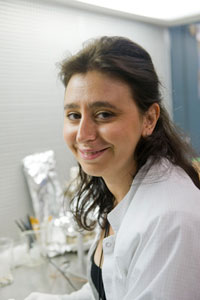 Anne-Marie Valente For thousands of years, craftsmen have applied gilding, a thin layer of gold, to objects to enhance their value. Now, Jefferson Lab researchers are using this same idea to enhance materials for accelerator science. As the number of uses for accelerators grows, scientists are faced with the challenge of building low-cost accelerators that offer high performance. And to meet that challenge, scientists at Jefferson Lab are combining a bit of the old with the new. Jefferson Lab SRF Institute Research Scientist Anne-Marie Valente and her colleagues are exploring the application of a thin film of niobium to other materials, such as copper, to make better accelerator components. "We want to replace, in certain projects, the bulk niobium with niobium on copper. The niobium on copper has potential advantages over bulk niobium," she explains. Jefferson Lab's Continuous Electron Beam Accelerator Facility accelerator depends on niobium, a rare metal, for more than 300 critical components. But during recent research and development efforts, JLab scientists reached the theoretical limit of niobium's performance, and it's still far short of what's needed for many proposed accelerator-based applications. In addition, niobium components are expensive, with individual units in CEBAF costing upwards of $30,000 each. 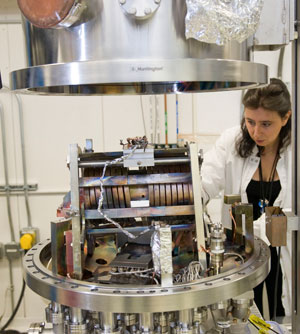 Anne-Marie Valente, SRF Institute research scientist, and her colleagues are using a technique called energetic condensation by electron cyclotron resonance to produce and apply thin films of niobium to copper, aluminum and other test metals in the ECR Plasma Deposition Lab.
Beyond Bulk Niobium Early linear accelerators used accelerating components made of copper. The metal was a good conductor of the energy, but copper accelerators have their limits. They are capable of handling continuously high fields to accelerate particles but can only be used for short periods without overheating. To get beyond these limitations, accelerator scientists turned to niobium. When chilled to near absolute zero, niobium becomes superconducting, losing its resistance to the flow of energy through it. This allows niobium accelerators to continuously accelerate particles at greater energies without overheating. However, niobium also has its limits. It is susceptible to developing "hot spots" on its surface when pushed to higher efficiencies. These hot spots are the result of impurities embedded in the niobium or defects on the component surface. "Because of the thermal properties of the niobium, you are not going to dissipate that energy, and you end up getting thermal breakdown," Valente explains. "With copper, you have a better chance of dissipating that energy, and that local heating is not going to be as critical or it's going to allow you to go further before you get to breakdown." 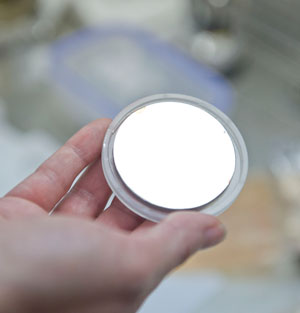 This is a test sample that has been coated with niobium.
Sputter-On Films Other laboratories have explored thin-film niobium on copper and other materials as an alternative to pure niobium components. "In some projects already, the niobium on copper has already been a good competitor to bulk niobium," Valente says. In the 1990s, for instance, accelerator scientists used a technique called sputtering to apply a thin film of niobium to copper accelerator components for the Large Electron-Positron Collider at CERN in Europe. The components exhibited many of the positive characteristics of bulk niobium components and were used at single-digit temperatures. But the thin-film-niobium-copper components in LEP did not reach the greater efficiencies needed for future accelerators. "The sputtering technique used for LEP generated a lot of defects in the film, and these can affect performance when you try to reach higher fields," Valente explains. LEP did demonstrate that thin-film-niobium-copper components can offer many of the benefits that bulk niobium components have over those made of copper. Valente aims to build on that work to optimize thin-film-niobium-copper component technology. JLab Holds 35 Precent of World's SRF Experience In Jefferson Lab's CEBAF accelerator, niobium accelerating components called cavities harness radiofrequency energy to accelerate particles. CEBAF was the very first large installation of superconducting radiofrequency accelerator technology, and scientists have been using the CEBAF accelerator to study the building blocks of matter for more than 15 years. In that time, the accelerator operators here have racked up more than 35 percent of the world's integrated operational SRF experience. The lab has also led SRF accelerator R&D, processing and assembling more than 500 SRF cavities since the lab's founding. Reaching Resonance Valente and her colleagues are using a technique called energetic condensation by electron cyclotron resonance to produce and apply thin films of niobium to copper, aluminum and other test metals in JLab's ECR Plasma Deposition Lab. In this technique, bulk niobium pellets are vaporized, and a cloud of electrons whipped into cycloidal motion by the effect of powerful magnets associated with an electrical field is used to ionize the niobium vapor. The niobium ions are than deposited on a copper sample. Altering the plasma or the energy of the niobium ions arriving on the sample affects the thickness and other properties of the thin film. Once the copper has been coated with niobium, the sample is analyzed. Analyses conducted on the sample, including Electron Backscatter Diffraction, X-ray diffraction, Transmission Electron Microscopy and Auger Electron Spectroscopy, are used to characterize the structure and surface of the film. Then, the samples are subjected to tests that predict their ability to accelerate particles. This is important should the samples be reproduced as accelerator components called cavities. "That's one of the things that we're trying to work on: producing films that we can apply to the surface of a cavity," Valente explains. "The objective is not just to create good films, but to optimize the SRF performance of the films." Once she and her colleagues have several good thin-film recipes for cavities, they aim to move beyond sample production to producing full cavities to test their performance in Jefferson Lab's cavity production facilities. 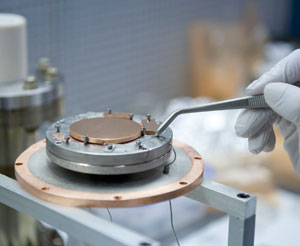 Here Anne-Marie Valente prepares a copper sample for the thin-film application process.
More Money-Saving Layers Valente and her colleagues are also testing the feasibility of multiple layers of different films to enhance performance. By layering, they hope to get better performance out of accelerator components, while operating them at higher temperatures than the current limit of single-digit temperatures above absolute zero. "You have a superconductor over an insulator over a superconductor. You're basically getting the qualities of the higher operating temperature material to enhance the performance of the niobium," Valente says. She says that while using less niobium in cavity production offers savings during construction of new accelerators, reducing the amount of refrigeration needed to run those accelerators can drastically reduce the ongoing operation costs over the lifetime of a machine. "If you operate at liquid helium temperatures, you wouldn't need such an expensive refrigerating system." Valente confirms. In the meantime, Valente and her colleagues are busy in the lab, pushing the boundaries of the science behind these ideas for producing ever more efficient, cheaper accelerators for a wide range of beneficial applications. By Kandice Carter Further Reading: |
Derbenev Wins R.R. Wilson Prize for Accelerator Achievements |
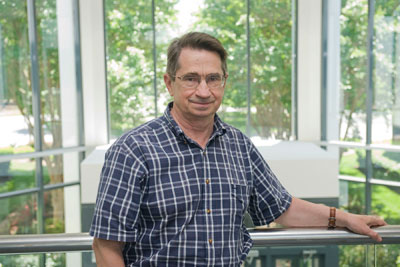 Yaroslav Derbenev
Accelerator Division Senior Staff Scientist Jefferson Lab Senior Staff Scientist Yaroslav Derbenev, from the Accelerator Division, has been named the recipient of the American Physical Society's 2011 Robert R. Wilson Prize for Achievement in the Physics of Particle Accelerators. The annual prize recognizes and encourages outstanding achievement in the physics of particle accelerators. Derbenev was honored "for a broad range of seminal contributions and innovations in beam physics, including theory and control of polarization with 'Siberian snakes,' electron and ionization cooling, round-to-flat beam transformations, Free-Electron Lasers and electron-ion colliders." He will receive a prize certificate, $7,500, and an allowance for travel to the meeting at which the prize is awarded. "I am especially pleased that the prize committee is recognizing conceptual development of the Electron-Ion Collider," Derbenev said, after learning of the award. "This is the result of many years of effort by JLab's nuclear and accelerator physicists to establish a viable perspective for a bright future of nuclear physics at Jefferson Lab." "The EIC proposal is now receiving serious support from JLab leadership and DOE," Derbenev affirmed. "It is a growing attraction for the nuclear and accelerator communities. Explorations into building the nuclear physics case and innovative developments in accelerator and detector design and technology have been made toward attaining the high luminosity, polarized beams needed for a CEBAF-based Electron-Ion Collider." In early August, Jefferson Lab hosted an international Beam Physics Symposium to honor Derbenev's lifetime of achievements in accelerator and beam physics and to celebrate his 70th birthday. Derbenev's distinguished career spans 50 years and stretches from Novosibirsk to Yerevan and from Ann Arbor, Mich., to JLab's Center for Advanced Studies of Accelerators. In 2007, Derbenev was awarded the U.S. Particle Accelerator School's 2007 Prize for Achievement in Accelerator Physics and Technology. He was honored for his seminal contributions to the theory of beam polarization in accelerators and its control with "Siberian snakes," the theory of electron cooling and the inventions of "round-to-flat" beam optics transformations and novel six-dimensional muon cooling schemes. The award was presented to him at the 2007 Particle Accelerator Conference in Albuquerque, New Mexico. Over the years he has authored or co-authored hundreds of papers and technical notes, participated in many conference proceedings and helped develop several reports. Slava, as he's known to his Jefferson Lab colleagues, graduated from Moscow State University with a master's in physics and then went on to the Budker Institute of Nuclear Physics in Novosibirsk for his doctorate. While working on his doctorate, Derbenev's supervisor took him to meet Gersh Budker. "He asked me about my work and was told that I was a theorist," Derbenev said with a laugh at the memory, "and he told me the world didn't need any more theorists." As a child he envisioned himself becoming an astronomer after his mother began to teach him about the night sky and gave him his first instruments, but his head was turned and his career course set by his high school physics teacher, who instilled in him a passion for science. His early career was spent working at BINP, the Institute of Complete Electric Drive in Novosibirsk and the Institute of Physics in Yerevan. He first came to the United States as a visiting accelerator physicist at the University of Michigan in Ann Arbor, and then went on to CERN and DESY before returning to the U.S. to work at SLAC. From 1990 to 2000, he was a visiting professor at the University of Michigan. He came to Jefferson Lab in 2001, where his work focuses on advanced concepts for a proposed electron-ion collider, radiofrequency control theory and new concepts for hard radiation sources, as well as development of new concepts for electron cooling of ions and ionization cooling of muon beams for the neutrino factory and the muon collider at FermiLab. "Being here is like a professional dream," he said. He and his wife, Svetlana, who worked in molecular spectography in Russia, live in Williamsburg. Their daughter and three grandchildren live in Novosibirsk, and his son and his family live in Philadelphia. He proudly notes that his oldest grandson is also into physics. Derbenev and Svetlana love to travel and have been on numerous European tours and cruises to the Caribbean. They've traveled the U.S. by car from Ann Arbor to San Francisco. An as yet unfilled dream is to visit Alaska. The scientist is a self-described "passionate listener" to all types of music and loves to play chess. |
Safety Pays at Jefferson Lab |
|
It's been said many times that safety pays, and at Jefferson Lab it's really true. The lab has a Safety Incentive Program, where an employee can receive as much as $100 for a major safety achievement. Other incentives under the program include a $50 award and modest gifts, such as a travel mugs or notebooks. "It pays to pay attention to safety," says Mary Logue, associate director of the Environment, Safety, Health and Quality Division. The purpose of this program is to encourage proactive safe behavior. "Safe behavior provides many benefits to all of us, and we want to reward and encourage those behaviors, activities and accomplishments that improve safety at the lab," she said. The program went into effect in 2006 and the monetary awards were added in May 2007. During fiscal year 2009, 11 individuals representing the Accelerator Division, Engineering Division, Facilities Management and Logistics, Project Management and Integration and ESH&Q received awards totaling $650. That number climbed during fiscal year 2010 to 17 individuals representing the Accelerator Division, Engineering Division, Information Technology Division, Facilities Management and Logistics, and ESH&Q, who received safety incentive awards totaling $1,350. Examples of the awards include: identifying a safety issue with emergency lighting and taking steps to get it addressed; identifying ergonomic handling fixtures for cryomodule disassembly activities; identifying a safety oversight loophole when ordering chemicals in Webstock, and for making a quick safety response to a flooding situation in the Test Lab. The program establishes three levels of awards:
The award certificate is presented to an employee by his or her supervisor, or a member of senior management. The monetary award follows either in the employee's next pay check or direct deposit statement. The Safety Incentive Certificate is on the Safety Incentive Program webpage; and it can be filled in or downloaded by the requesting supervisor. "This program is the result of careful consideration among management and staff; these incentives strengthen and encourage everyone's investment in safety at the lab," Logue said. "We encourage staff to proactively identify safety issues and to address them in the most appropriate manner. And we also encourage supervisors to identify and to recognize individuals for exhibiting exemplary safety initiatives," she added. More information about the Safety Incentive Program, and the monetary award submission form, can be found on JLab's Environment, Safety, Health and Quality webpage, under the link labeled Safety Incentive Program or by going directly to http://www.jlab.org/ehs/safety_award.html. For assistance in submitting an employee for one of these awards, contact Tina Menefee, ext. 5490 or email menefee@jlab.org . Recipients of Safety Achievement and Director's Safety awards for FY10 can be viewed by signing in to JLab's Insight Front Page and visiting the Jefferson Lab Safety Snapshot portlet. Individuals Awarded FY10 Safety Incentive Awards These individuals, representing the Accelerator Division, Engineering Division, Information Technology Division, Facilities Management and Logistics, and ESH&Q received safety incentive awards totaling $1,350 during the 2010 fiscal year. Recipients included (in chronological order of award): "These individuals are major contributors to our safety culture. They show co-workers the right way to react to unsafe situations and also allow the lab to systematically prevent injuries. It's as important as any part of our safety program at Jefferson Lab," said Mary Logue, associate director of the Environment, Safety, Health and Quality Division. "We thank each of these individuals for their time, effort and insight. Their efforts were above their normal job requirements and in many cases required time well beyond normal work hours. Their efforts helped to make the lab community a safer place to work. We encourage staff to proactively identify safety issues and to address them in the most appropriate manner. And we also encourage supervisors to identify and to recognize individuals for exhibiting exemplary safety initiatives," she added. For more information about the Safety Incentive program, visit: http://www.jlab.org/ehs/safety_award.html |
Jefferson Lab Recognizes Inventors |
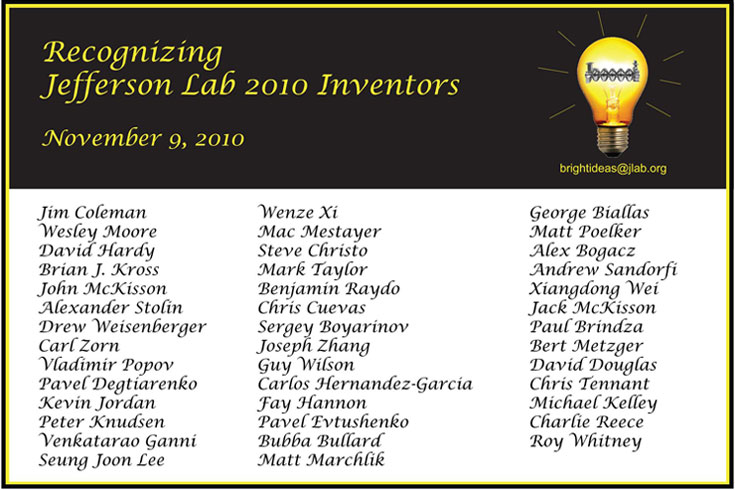 The 41 Jefferson Lab staff members who submitted an invention disclosure in 2010 are listed on the pictured banner.
In November, Jefferson Lab honored individuals who submitted bright ideas for potential patenting. Laboratory staffers who had submitted an invention disclosure in fiscal year 2010 were treated to a pizza party, a certificate of achievement and a mug. Jefferson Lab Chief Technology Officer Roy Whitney said the purpose of the event was to recognize the efforts of the laboratory's many creative individuals. "Many of our inventors came upon challenges during the course of their work beyond what could be solved with existing technologies or made discoveries in their research that led to ideas for new technologies," he said. "They discovered new ideas or engineered or designed new products that may be of use to industries beyond the laboratory. We're here to honor their ingenuity, insight and hard work." Jefferson Lab Director Hugh Montgomery encouraged all employees to consider the application potential of the ideas that they develop as part of their work. "It's extremely important that we have participation at a broad level. Because it's only from a base that's broad that we can get the ideas that go forward to a patent," Montgomery said. Wide-ranging ideas generated by Jefferson Lab inventors in the past that have become patents include designs for an electronic stockroom, a helium process cycle and a serpentine metal gasket. The inventors on each patent issued share a $500 cash award from Jefferson Lab's Management and Operating contractor, Jefferson Science Associates, LLC. When a patent is licensed, JSA and the inventor(s) share the resulting royalties on a 50-50 basis after administrative costs have been recovered. "So, if you are worried that you are doing stuff that wasn't really encouraged, then you can rest assured that it is encouraged and your supervisors should be really happy when you come up with ideas," Montgomery said. "And certainly, we in the administration at Jefferson Lab encourage you to take the time and dedicate the effort to submitting your ideas as invention disclosures." Whitney concurred. "I'd particularly like to thank the staff that came up with these bright ideas and their supervisors for supporting their employees' work," he said. "We just wanted to let you know that while this is one of the expectations of all Jefferson Lab employees, we do recognize the extra effort that it takes to follow through and submit your ideas. So thanks again." To enter your bright ideas for consideration for patenting, visit the Jefferson Lab Technology Transfer website. A list of all Jefferson Lab employees who submitted an invention disclosure in 2010 is displayed on the pictured banner. |
Michalski Tackles Engineering Division's Deputy Duties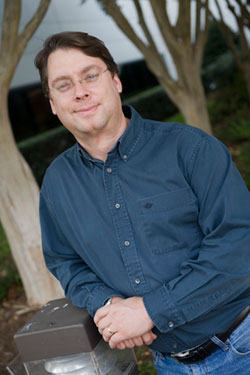 Tim Michalski
Tim Michalski (he’ll tell you it means "son of Michael" in Polish) was born early – and with little advance notice – in the back bedroom of his parent’s home in Buffalo, N.Y. He was delivered by his dad, aunt and uncle. The third of four boys, he excelled in math and science in the schools he attended throughout his youth in upstate New York in the towns of Hamlin and Brockport. When he took an elective class in mechanical drafting during his senior year, he discovered engineering – a field in which he could combine his skills and interests. He set out on the rigorous five-year engineering program at Rochester Institute for Technology, which offered him the opportunity to work and gain hands-on experience, while earning his degree,. Nineteen eighty-eight was a big year for Michalski. He landed a permanent job with Harris Corp. in Rochester, where he was involved in working with military radio equipment for the Army and Navy, and other projects under government contracts; he received his bachelor's degree, and he married Monica, whom he'd met when he was in seventh grade and she was in sixth. By the time he left Harris 10 years later, he was managing 55 people in its mechanical engineering, design and drafting group. He'd also been to the White House as a guest of then-Vice President Al Gore. He was part of a group of Harris employees that teamed up with Edison Technical High School and RIT to win the national US FIRST robotics design competition. He had started work on his master's in mechanical engineering at RIT while working at Harris, and in the midst of it, he changed companies to Philips Broadband Networks in Manlius, N.Y. It was the farthest east he had ever lived, and often receives the "Golden Snowball Award" for its annual accumulation of the cold, white stuff. While there, he completed his master's in engineering management at Syracuse University. "We had 200-plus inches of snow a year, and there were days that the driveway had to be shoveled or blown out three or four times," he noted with a sigh. When his division was sold to another company, Michalski took a job with Borg Warner in Ithaca. There, he worked on engine timing drives for auto makers such as Hyundai, Mitsubishi and Chrysler and ended up once again rising from a system engineer into a management position. He saw the auto downturn coming and began to scout other opportunities. His former boss from Philips was at a small start-up technology company called AdaptivEnergy in Hampton and invited him down to build an engineering and manufacturing organization from the ground up. When the family arrived, they were awestruck by the Hampton Roads weather. They continue to be. "I love the heat and humidity," he said. "I don’t even use the air conditioning in my car!" Over the five years he worked at AdaptivEnergy, he held positions as a project engineer, director of engineering, and then vice president and general manager, which covered engineering, sales, marketing, product development and intellectual property. "This was a phenomenal learning experience for me," Michalski noted. Throughout his career, he's had the opportunity to travel around the world: from Mexico to Europe and Asia. Belgium and Germany particularly caught his eye. "I'd like to see more of those countries," he said. Unfortunately, as happens often with small companies, time overtook capital and the company closed last year. Nonetheless, he and his family wanted to stay in this area, and in the spring he was hired as Will Oren's deputy in the Engineering Division. "Much of what I'm doing here is similar to work I've done before," Michalski pointed out, "but the lab and research environment are very different. There's a longer-term vision and, as a Department of Energy lab, there is not the same monthly and quarterly financial pressure that there is in private industry. I'm thrilled to work with the folks here – they're extremely intelligent, hard working and committed." The Michalskis live in York County, where their daughters Emily and Hannah go to school. Their oldest daughter, Amanda is at Longwood University studying elementary education to become a teacher. It's been a challenging year for the family, with Tim's job loss and initial frustration at finding another, and then both of Monica's parents passing away after battling cancer. They have relied on their family, faith, and their many friends at Yorkminster Presbyterian Church, where they are active in several groups, to get through the challenges. "It's a rewarding feeling that you can go through such trials, coming out the other side a stronger person," Michalski said. "And this position at Jefferson Lab is really a shining light in our lives. We've been very blessed." By Judi Tull NSC Technologies Joins DOE Mentor-Protégé Program With JLab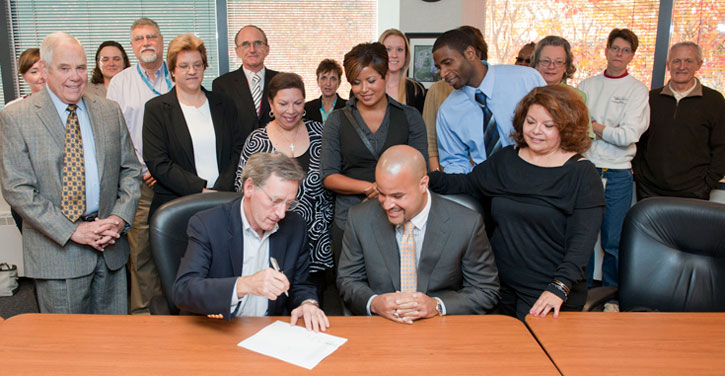 Mike Dallas, Jefferson Lab's chief operating officer (center, left) signs a mentor-protégé agreement with Paul Rodriguez, president and founder of NSC Technologies, Inc. They are surrounded by members of JLab's Chief Finance Officer's group and members of the NSC team. The business has a multi-year agreement to provide temporary workforce staffing for Jefferson Lab's 12 GeV Upgrade project.
NSC_Technologies, Inc., a Virginia-based professional staffing business, has signed a multi-year Mentor-Protégé Agreement with Jefferson Science Associates, LLC, the management and operations contractor for the U.S. Department of Energy's Jefferson Lab. The Mentor-Protégé program is designed for DOE prime contractors like JSA to mentor and guide woman- and minority-owned businesses – so they have the opportunity to become new business resources within the DOE vendor community and the larger government-vendor community, according to Danny L. Lloyd, Jefferson Lab's Small Business Program manager. NSC is a federally certified minority-owned business and a Virginia Class A Commercial Contractor. Initially, NSC will provide services to Jefferson Lab's Engineering Division. NSC will screen candidates, handle interviews, coordinate training and handle electronic time sheets for the temporary workforce needed for the lab's 12 GeV Upgrade project. This project is a multi-year, $310 million effort that will double the energy of the lab's electron accelerator. "We will need significant contract staffing for the two accelerator shutdowns being planned to accommodate 12 GeV Upgrade work," explained Will Oren, Engineering Division head, "for the six-month down starting in May 2011 and the year-long down that will follow in 2012." "We needed to find a way to quickly ramp up our staffing to meet the workload for those periods. With NSC, we will be able to use this blanket ordering agreement for bringing on temporary staff instead of many individual purchase requests," Oren added. "Helping us ramp up quickly for our shutdown workload will be a win-win opportunity for both Jefferson Lab and NSC Technologies," said Mike Dallas, Jefferson Lab's chief operating officer. The business, led by Paul Rodriguez, president and founder, focuses on providing skilled trades, technical and engineering temporary workforce staffing solutions. The nearly decade old company, based in Portsmouth, provides full-service capabilities throughout Virginia and Puerto Rico and in San Diego and Honolulu. NSC customers include leaders in the defense and ship repair industries. Finding an experienced and qualified contingent workforce is a stressful, time consuming and expensive process, according to Rodriguez. "We are honored to be here and appreciate the opportunity. NSC is committed to reduce hiring frustrations, by offering a responsive and cost-effective temporary service solution that allows our customers to focus on the core goals and demands of their business," he said. Jefferson Science Associates established a four-year (with one additional option year) Mentor-Protégé Agreement with the company. Members of Jefferson Lab management, Procurement and the Engineering Division welcomed NSC Technologies team members gathered at Jefferson Lab on Nov. 23 for the agreement signing. Engineering Rolls Out Professional Development Program in January; Starts With Cool Topic: Cryogenics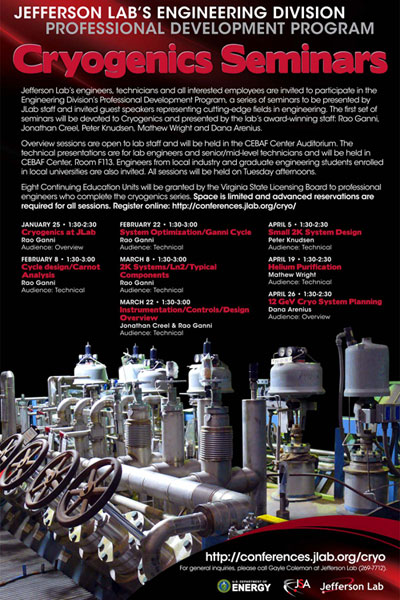 The Engineering Division is responsible for a complex and challenging technical scope of work at Jefferson Lab. To help sustain top-notch performance, division leadership is establishing a professional development program to build on the technical knowledge and skill set of the lab's engineering and technical staff. Leadership plans to set the program's agenda on an annual basis. For each agenda topic, both a broad overview and highly specialized seminars will be offered. Presentations will be made by lab staff having expertise in the selected subject area. On occasion, a guest speaker, representing an engineering field of interest, will be invited to make a presentation. The first set of seminars, set to begin on Jan. 25, will be devoted to cryogenics and presented by members of the lab's award-winning cryogenics staff: Rao Ganni, Jonathan Creel, Peter Knudsen, Mathew Wright and Dana Arenius. The overview sessions will be held in the CEBAF Center auditorium and will be open to all lab engineers and technicians, as well as interested staff, graduate students and users. The technical presentations are geared for lab engineers, and mid- and senior-level technicians and will be held in CEBAF Center Room F113. Engineers from local industry and government entities, and students enrolled in engineering programs at local universities are also invited. All sessions are scheduled for Tuesday afternoons. Eight Continuing Education Units will be granted by the Virginia State Licensing Board to professional engineers who complete the cryogenics series. Space is limited and advance reservations are required for all sessions. See posters distributed around the lab or visit the webpage for details about all scheduled cryogenics sessions. Register online at: http://conferences.jlab.org/cryo/ For quite some time we've wanted to start an engineering seminar series to share common experiences and designs across the lab's engineering community, according to Will Oren, Engineering Division head. "We are excited to be kicking it off," he said. "In view of many new staff, the interesting engineering problems we solve each day, the need to pass on our experiences so we don't reinvent solutions to common problems and the desire to reach out to local commercial, government and academic communities, we decided to elevate the seminar series to a professional development program." The fledgling program will be assessed after this first session and periodically thereafter. "If we have been successful, we will continue the program and expand into other unique subject areas within the lab, and take advantage of local contacts to bring in topics not necessarily specifically related to lab projects," Oren said. Recycling Reduces Waste Volume, Promotes Environmental StewardshipJefferson Lab is committed to having a safe, productive and energy-efficient workplace, which includes being a good environmental steward. To this end, the lab has a waste minimization and pollution prevention program, and recycling is a critical part of this program. During fiscal year 2010, the lab recycled more than 1,742 tons of materials. "That is 1,742 tons of reclaimable waste that didn't end up in a landfill," notes Mike Lewellen, Facilities Management and Logistics. The lab provides mechanisms for collecting a variety of materials that can be recycled or reused, and lab leadership encourages everyone to reuse materials when feasible and to handle all recyclable materials as appropriate. Co-mingle Office Recyclables Some types of recyclable materials at Jefferson Lab may be co-mingled, while other items must be handled separately. "In general, individuals are very conscientious about putting office paper, envelopes, phone books and magazines into the blue recycling bins found in offices and many common areas. However, we can do better by increasing general awareness on how to handle other types of recyclable or reclaimable waste," Lewellen says. "For example, several other types of recyclables may be deposited directly into these blue recycling containers – right along with paper items." Aluminum, steel and bi-metal food and beverage cans, glass bottles, marked 1 and 2 plastic containers and small pieces of single-ply and corrugated cardboard may also go into these recycling containers. Food and drink items must be empty and rinsed out; lids should be removed and disposed of in the trash. Cardboard boxes and large pieces of cardboard should be flattened, "recycle" written on the top piece, and stacked adjacent to waste and recycling containers. Central Collection for Bulk Recyclables Other types of recyclable materials are collected and handled separately and include: wood pallets; wood scrap, beams and packing crates; scrap metals and wiring; batteries; all types of toner cartridges and fluorescent light bulbs. Many of these items, and other types of recyclable waste, are collected at the Central Material Storage Area located east of the Test Lab, Building 58, at the end of BCS Road. Additional information about the CMSA, and points of contact for accessing the area, is available in an Aug. 4, 2010 All Staff memo. Ensuring that waste and recycling materials get disposed of properly is the responsibility of the person or work center that generated them. In an office setting that can be as simple as tossing something into a recycling container or a wastebasket. In work centers, it is best to assign an area where waste and recycling can be gathered and separated. Empty boxes must be broken down and clearly labeled "Recycling." Oversized or large waste and recycling materials must be moved to the Central Material Storage Area. Work center staff may deliver the materials to the CMSA or submit a Facilities Management and Logistics Work Order to have the materials picked up and delivered to the CMSA. Turn in Excess, Unused Materials Excess, usable office supplies should be returned to the work center that supplied them, the support staff they were ordered through or turned over to Free Stock. Unused or excess tools and equipment and usable materials should be turned in to Free Stock or the Tool Crib, so they may be used by someone else for JLab work. "Help support our efforts to reduce waste by recycling. We owe it to ourselves and the taxpayer to turn in usable, surplus materials so others may use them," he said. Fluorescent light bulbs contain mercury, which is a hazardous chemical. Burned out fluorescent bulbs should not be thrown out. Submit a Facilities Management and Logistics Work Order so burned out fluorescent bulbs can be picked up. Jefferson Lab management wants to continue reducing the amount of waste sent to the landfill and increasing the lab's recycling to landfill waste ratio. Both of these activities are performance objective areas in the lab's performance-based contract with the Department of Energy. The lab's waste minimization and pollution prevention program is part of its Environmental Management System. During 2010, recycling efforts at the lab were important aspects for two of the lab's four EMS objectives. The two objectives were: to continually improve the lab's stewardship of the environment and to enhance its pollution prevention program. For guidance on handling recyclables and excess property and accessing Free Stock and the Tool Crib, download this one-page reference sheet. Questions about recycling, as well as requests to temporarily use the large blue recycling containers and large black waste barrels, may be directed to Lewellen, ext. 7169, lewellen@jlab.org . Contact Lamont Williams, ext. 6270, lamont@jlab.org , with questions regarding excess property; and contact Lawrence Ferbee, Jr., ext. 6297, ferbee@jlab.org , regarding the Tool Crib and Free Stock. Share ideas for improving the lab's waste minimization/pollution prevention program with Bill Rainey, environmental engineer, Environmental, Safety, Health and Quality Division, at ext. 7898 or wrainey@jlab.org. 'Tis the Season for eCard Scams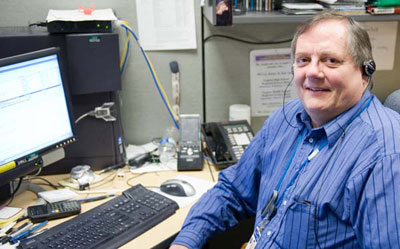 Greg Nowicki, JLab's cybersecurity analyst, encourages all lab computer account holders to be wary of eCards and phishing scams at all times, but especially over the holidays.
Be wary of holiday eCard scams and cyber attacks. The holidays are here again, and with them come the yearly flood of electronic greeting card scams. As popular as eCards are with your brother Phil and your Aunt Lucy, they're even more popular with Internet fraudsters. Being aware and following safe practices can help individuals from learning this, firsthand. This year more than ever, the eCard you receive might be legit, or it might be an attempt to trick you into giving an attacker access to the information on your PC, according to Greg Nowicki, Jefferson Lab's Cybersecurity analyst. "There is email out there spreading links to sites which, if visited using a browser, could infect your computer," Nowicki points out. "Usually they don't wipe out your computer now-a-days, but use it to spread more spam and steal your personal information. And that can have longer lasting consequences than ruining your hard drive." The e-thieves' biggest targets are credit card numbers, bank account details and other information that could help them steal both your identity and your money. Worse, the eCards themselves can appear to come from legitimate sites or to have been sent by your actual friends and relatives. Telling the legitimate eCards apart from the scams can be very difficult, and guessing incorrectly can cause real problems. So what can you do to help protect yourself (and JLab) from this type of attack? Here are some tips: When you receive one of these electronic cards (and odds are that you will), ask yourself, "Does this look suspicious in any way?" If so, simply delete the message and bask in the knowledge that you've helped maintain the lab's cybersecurity and protected your personal information. If you'd like to do some additional reading on eCard scams, here are several good URLs to start with: If you have questions, contact the Computer Center HelpDesk at helpdesk@jlab.org . Ring In the New Year with a Reduced InboxYear after year, one of the most popular New Year's resolutions is to become better organized. Now, the Computing and Networking Infrastructure group is here to help JLab computer account holders with that resolution – at least, as it applies to a JLab computer account holder's e-mail inbox. If your e-mail inbox is bursting at the seams, this is the perfect time to clear it out. Clearing out your inbox before the holiday shutdown means that you'll come back to a fresh inbox in January and a head start on being better organized. But the benefits don't stop there. A small inbox is also good for the e-mail system. Large inboxes slow the delivery of e-mails to yourself and other e-mail users at Jefferson Lab. What's more, e-mail inbox space tops out at two Gigabytes. Once your inbox hits 2 GB, all new messages will bounce until you free up some space in your inbox. That means that you won't receive any new e-mails, and all new e-mails will be returned to the sender with a message stating that your e-mail inbox is full (i.e., overstuffed). Some simple steps for freeing up space in your inbox are available at: https://cc.jlab.org/emailmaintenance Probing the Proton's Weak SideScientists know that the sun gets its shine through the actions of a little-understood fundamental force of nature called the weak force. But there's a lot that they don't know about the weak force. For the first time, researchers at Jefferson Lab are trying to precisely measure the weak force's grasp on the ubiquitous proton. https://www.jlab.org/news/stories/probing-protons-weak-side SRF Institute Leads the Way Toward Clean CavitiesA team at Jefferson Lab's Superconducting Radiofrequency Institute has developed a detailed set of rules for optimal cleaning of niobium cavities. Team members have been working on a regimen for removing imperfections and impurities from superconducting radiofrequency niobium cavities. Their procedures, they believe, have helped create cavities that could exceed International Linear Collider 2010 performance benchmarks. Milestones for November 2010Hello Scott Conrad, Mechanical Engineer, Facilities Management and Logistics Goodbye Pavel Chevtsov, Control System Computer Scientist, Accelerator Division These Milestone entries, listed alphabetically, are full-time, term, casual and student actions posted by Human Resources for November 2010. Jefferson Lab is currently seeking qualified individuals for a range of engineering positions as well some scientific, managerial, technical, administrative and student intern positions. More than 20 JLab employment opportunities are posted at: http://www.jlab-jobs.com/. Congratulations Carlos Muñoz Camacho received a 2010 CNRS Bronze Medal for research he conducted at Jefferson Lab. The award "recognizes a researcher's first work, which makes that person a specialist with talent in a particular field." Muñoz Camacho is currently based at the Laboratoire de Physique Corpusculaire of Clermont-Ferrand, a laboratory jointly supported by the French national research center (CNRS) and Université Blaise Pascal. The 2010 recipients are posted at: www.cnrs.fr/fr/recherche/prix/medaillesbronze.htm
|
|
The On Target newsletter is published monthly by the Thomas Jefferson National Accelerator Facility (Jefferson Lab), a nuclear physics research laboratory in Newport News, Virginia, operated by Jefferson Science Associates, LLC, for the U.S. Department of Energy's Office of Science. Possible news items and ideas for future stories may be emailed to jlabinfo@jlab.org, or sent to the Jefferson Lab Public Affairs Office, Suite 15, 12000 Jefferson Avenue, Newport News, VA 23606
|


 Jefferson Lab Senior Staff Scientist Yaroslav Derbenev, from the Accelerator Division, has been named the recipient of the American Physical Society's 2011 Robert R. Wilson Prize for Achievement in the Physics of Particle Accelerators........
Jefferson Lab Senior Staff Scientist Yaroslav Derbenev, from the Accelerator Division, has been named the recipient of the American Physical Society's 2011 Robert R. Wilson Prize for Achievement in the Physics of Particle Accelerators........ It's been said many times that safety pays, and at Jefferson Lab it's really true.
It's been said many times that safety pays, and at Jefferson Lab it's really true. In November, Jefferson Lab honored individuals who submitted bright ideas for potential patenting. Laboratory staffers who had submitted an
In November, Jefferson Lab honored individuals who submitted bright ideas for potential patenting. Laboratory staffers who had submitted an